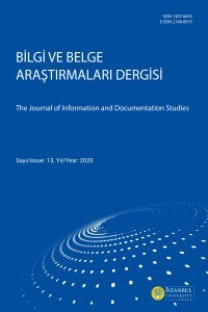Elektronik Belge Yönetimi Uygulamalarında Personel Farkındalığının Artırılması: Değişim Yönetimi Açısından Bir İnceleme
Öz
Günümüzde kurumlar, geleneksel usulle yönettikleri iş ve işlemleri hizmet, kali-te standardı, verimlilik, teknolojinin gelişimi ve yasal zorunluluklar gibi etmen-lerden dolayı elektronik ortama taşıma ihtiyacı hissetmektedirler. Bunun sonu-cunda Amerika Birleşik Devletleri’nde ve Avrupa Birliği ülkelerinde Elektronik Belge Yönetim Sistemi (EBYS) geçişlerinin hız kazandığı görülmektedir. Türki-ye’de özellikle kamu kurum ve kuruluşlarında bilgi toplumu eylem planı çerçe-vesinde uygulanan EBYS geçişlerinde sürdürülebilirliğin sağlanması adına sis-temin birtakım dinamikler üzerinde oluşması gerektiği görülmüştür. Bu çalış-mada bahsedilen dinamiklerden biri olan “sistem kullanıcıları olarak personelin yenilikçi bir bakış açısıyla değişim ve dönüşümü kabul edip farkındalık sağlan-ması” konusu ele alınmıştır. Çalışmanın amacı EBYS geçişlerinde personel far-VAROL SAYDAM24kındalığının artırılması ile bu farkındalığın uygulama sürecine etkilerini açığa çı-karmaktır.Anahtar Sözcükler: Personel farkındalığı, elektronik belge yönetim sistemi (EBYS), değişim yönetimi.AbstractDue to factors such as customer service, quality standards, productivity, the de-velopment of technology and legal compliance, organisations today have felt the need to transfer the business activities they traditionally managed to an electro-nic environment. As a result of this the transition to Electronic Records Mana-gement Systems (ERMS) in both the United States of America and European Un-ion nations was realised at a fast past. It has been determined that the continu-ity of ERMS implementation which is being carried out within the context of in-formation society action plans particularly within Turkish public institutions and organisations, has to be based on a number of system dynamics.This study focuses on the one of the primary dynamics of “raising the awareness of person-nel through acceptance of change and transformation from an innovative pers-pective as system users.” The aim of this study is to raise the awareness of per-sonnel in the transition to ERMS and to determine the effects of this awareness on the implementation process.Keywords: Personnel awareness, electronic records management system(ERMS), change management.
Anahtar Kelimeler:
Personel farkındalığı, elektronik belge yönetim sistemi (EBYS), değişim yönetimi
___
- Bailey, S., Vidyarthi, J. (2010). Human Computer Interaction: The Missing Piece of the Re-cords Management Puzzle. Records Management Journal, 20(3), 2010, 279-290. Beder, F., Elektronik Belge Yönetim Sistemi ve Türkiye Cumhuriyeti Merkez Bankası Örneği. Türkiye Cumhuriyeti Merkez Bankası İletişim Genel Müdürlüğü, Ankara, 2009. Borglund, E., Anderson, K., Samuelson, G. (2009). How Requirements of Record Managers Change After Implementing New Electronic Records Management Systems. The 3rdEuropean Conference on Information Management and Evaluation. ed. Jan Ljungberg ve Kerstin Grunden, University of Gothenburg, Sweden on 17-18 September, 59-66. Budak, D. (2011). Uygulanan Eğitim Programlarının Etkilerine İlişkin Çalışanların Algıları Üzerine Bir Araştırma. Marmara Üniversitesi Sosyal Bilimler Enstitüsü, İstanbul. Çiçek, N. (2011). Örgütlerde Elektronik Belge Yönetimi Programlarının Kurulmasında Bilgi ve Belge Uzmanlarının Rolü: E-Belediyecilik Örneği. International 9th Conference on Knowledge, Economy and Management Proceedings, (June 23-25, 2011 Sarajevo-Bosnia and Herzegovina) ed. Zaki Parlak, İbrahim Güran Yumuşak, Sarajevo: Gar-mond, 109-119. Downing, L. (2009). Implementing EDMS: Putting People First. The Information Management Journal, July/August, 44-50. Gregory, K. (2005). Implementing an Electronic Records Management System: A Public Sec-tor Case Study. Records Management Journal, 15(2), 80-85. Gunnlaugsdottir, J. (2009): The Human Side of ERMS: An Icelandic Study. Records Mana-gement Journal, 19(1), 54-72. Henriksen, H. Z., Andersen, K. V. (2008). Electronic Records Management Systems Imple-mentation in the Pakistani Local Government. Records Management Journal, 18(1), 40-52. International Records Management Trust (2009). Training in Electronic Records Management, Module Planning and Managing Electronic Records Management Programme. United Kingdom, IRMT. Johnston, G. P., Bowen, D. V. (2005). The Benefits of Electronic Records Management Sys-tems: A General Review of Published and Some Unpublished Cases. Records Manage-ment Journal, 15(3), 131-140. Johare, R., Masrek, M. N., Sa’ari, H. (2013). Information Technology Leadership on Electronic Records Management: The Malaysian Experience. The 9th European Conference on Management Leadership and Governance, ed. Dr. Maria Th. Semmelrock-Picej ve Dr. Ales Novak, Avusturya, 105-113. Kandur, H. (2011). Türkiye’de Kamu Kurumlarında Elektronik Belge Yönetimi: Mevcut Du-rum Analizi ve Farkındalığın Artırılması Çalışmaları. Bilgi Dünyası, 12(1), 2-12. Leikums, T. (2012).Managing Human Factors in Implementing Electronic Document Sys-tems in the Public Sector. Romanian Review of Social Sciences 2, 21-30. The British Standarts Institution (2001). ISO/TR 15489-1 “Information and Documentation, Records Management: Part 1: General. United Kingdom. Türkiye Bilişim Derneği (2009). Elektronik Belge Yönetimi. TBD. Young, J. (2005). Electronic Records Management on a Shoestring: Three Case Studies. The Information Management Journal,January/Fabruary, 58-61
- ISSN: 1307-6655
- Yayın Aralığı: Yılda 2 Sayı
- Başlangıç: 2008
- Yayıncı: İstanbul Üniversitesi
